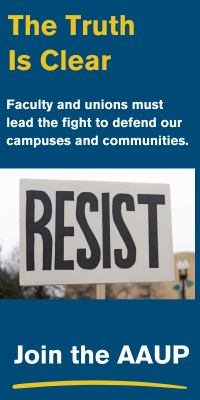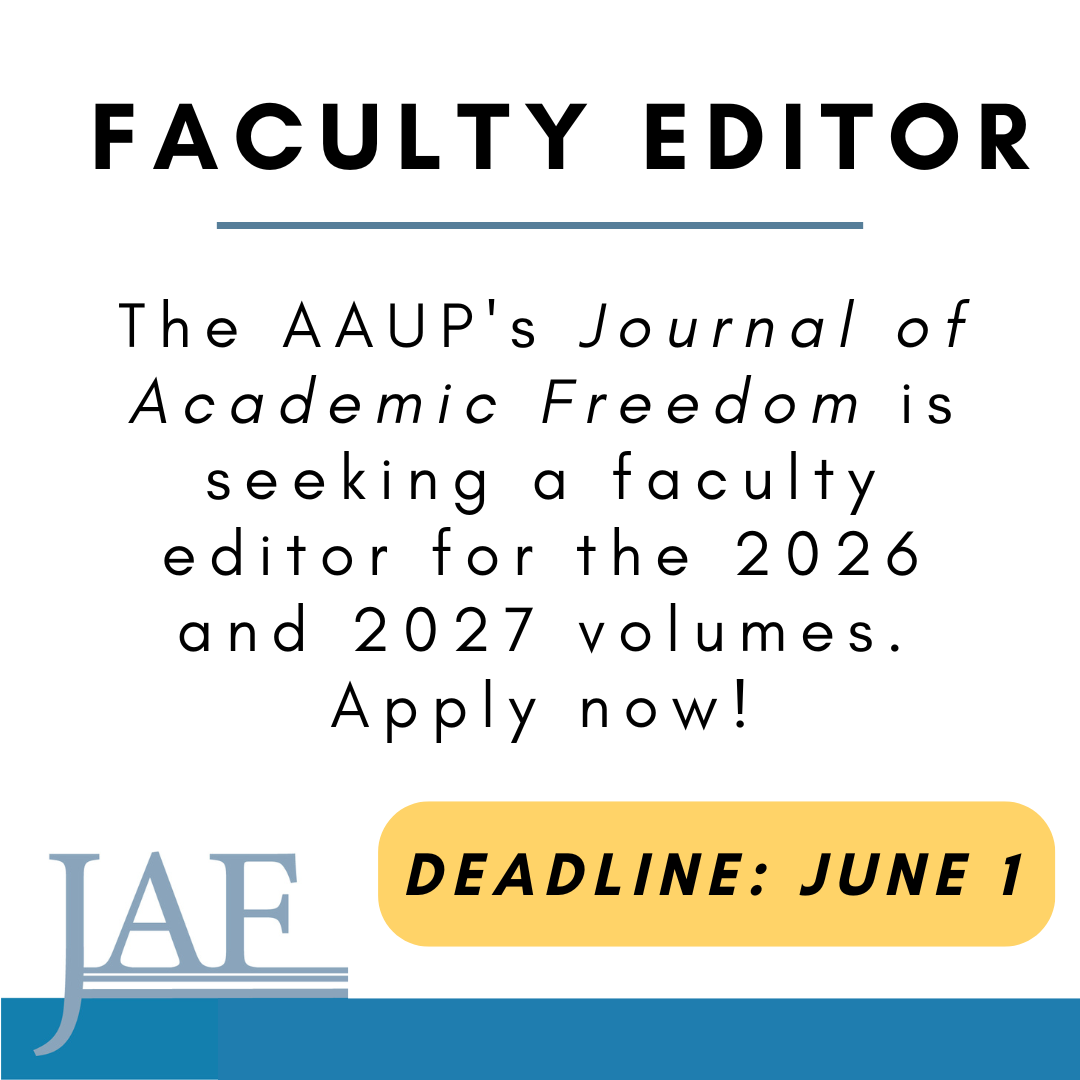- About
- Programs
- Issues
- Academic Freedom
- Political Attacks on Higher Education
- Resources on Collective Bargaining
- Shared Governance
- Campus Protests
- Faculty Compensation
- Racial Justice
- Diversity in Higher Ed
- Financial Crisis
- Privatization and OPMs
- Contingent Faculty Positions
- Tenure
- Workplace Issues
- Gender and Sexuality in Higher Ed
- Targeted Harassment
- Intellectual Property & Copyright
- Civility
- The Family and Medical Leave Act
- Pregnancy in the Academy
- Publications
- Data
- News
- Membership
- Chapters
Negotiating Redbook Policies
Collective bargaining as a bulwark against erosion of AAUP policies.

For over five decades following its founding in 1915, the AAUP carried out its mission outside of the realm of collective bargaining. The organization formulated policy on a constantly evolving range of issues of concern to higher education and worked to have those policies adopted by individual institutions and public higher education systems. The primary mechanism employed consisted of encouraging faculty to use their participation in institutional governance to work toward policy adoption. The AAUP also interacted directly—including in the initial formulation of policy pronouncements and in joint endorsements—with organizations representing the interests of administrators and trustees. Finally, it carried out visible “enforcement” activities (primarily investigations leading to censure and sanction, arising from violations of academic freedom and shared governance, respectively).
Beginning in earnest in the late 1960s, faculty fundamentally expanded the means by which policy matters were addressed at the campus and system levels. The new dimension of faculty influence came about as faculty began to acquire collective bargaining rights. At first, faculty unionization was carried out almost exclusively under the auspices of the American Federation of Teachers and the National Education Association. After a good deal of internal deliberation, however, the AAUP abandoned its historical opposition to bargaining on the part of professors and began organizing aggressively on both public- and private-sector campuses. Today, following the AAUP’s 2022 affiliation with the AFT, more than ninety AAUP-AFT chapters have collective bargaining agreements in place to advance the interests of tenured, tenure-track, and non-tenure-track faculty—both full-time and part-time—and of graduate student employees, postdoctoral fellows, and various types of academic professionals. The institutions with active unionized chapters range from two-year colleges to research universities.
The AAUP’s turn to collective bargaining grew out of a more expansive view of unionization than is typical for US labor unions. The mission of the AAUP incorporates a concern with addressing economic matters, as does the mission of unions generally—thus the declaration in the 1973 Statement on Collective Bargaining that the AAUP is committed to “promoting the economic well-being of faculty and other academic professionals.” But at the heart of the AAUP’s formal endorsement of academic unionism was the belief that collective bargaining could be an effective means of achieving the AAUP’s primary objectives, notably identified in that statement as “protecting academic freedom [and] institutions of faculty governance.”
Navigating the Practical Complications
A key practical question that arose from the outset was precisely how faculty could effectively utilize collective bargaining in tandem with shared governance to translate AAUP-recommended policies into binding provisions of academic life. The transmission of principles from the policy documents and reports collected in the AAUP’s Redbook into contract language is quite a bit less straightforward than it might appear at first blush. There are a number of complicating factors. First, some AAUP policy documents are not readily adaptable to contract language because they address only in broad terms the principles that should determine how institutions of higher education conduct themselves in various areas. Other AAUP documents, though—most notably the Recommended Institutional Regulations on Academic Freedom and Tenure—are more easily translatable into binding contractual documents, since they are written in language suitable for use by higher education institutions and set forth specific procedures that ought to be in place on each campus.
A second complicating factor arises out of what is known as “negotiability.” The various legal statutes regulating collective bargaining incorporate different limits with respect to the parties’ obligations and abilities to negotiate particular subjects. Collective bargaining topics fall into one of three categories: “mandatory subjects,” which must be bargained at the request of either party; “permissive subjects,” which may be bargained by mutual consent; and “unlawful subjects,” about which the parties are not permitted to bargain. It is common for disagreements to arise over the proper categorization of academic freedom and shared governance provisions. Thus, a preliminary battle at the bargaining table often centers on whether the parties will negotiate at all over matters addressed in the Redbook, even before specific proposals are exchanged.
A related thorny issue arises over the respective roles of the two mechanisms by which the faculty voice is exercised on a campus. Academic freedom, for example, clearly has elements of academic decision-making, an area where faculty senates have jurisdiction. But the exercise of academic freedom can also involve questions of job security and working conditions, and, to that extent, it is within the union’s bailiwick. A necessary starting point, therefore, is determining what the division of responsibility between the senate and the union will be. Only once this is clarified can union negotiators begin the work of bargaining protections for academic freedom into collective bargaining agreements. Quite often, the baby is split in half. So, for example, faculty working through governance bodies might determine the content of an institution-wide academic freedom policy, while faculty in their union capacity might take the lead in establishing specific related procedural aspects, such as applicable time frames for challenging adverse personnel actions taken by the administration and for the functioning of appeal or grievance mechanisms. Making this determination even less straightforward is the fact that the composition of a senate is never identical to that of a bargaining unit. Some faculty senates use a narrow definition of “faculty,” which may well exclude some academic professionals with teaching and research responsibilities or even faculty serving on contingent appointments, while others use an expansive definition that can include employees with responsibilities other than teaching or research. And collective bargaining units are defined differently at different institutions, with some excluding faculty on part-time appointments or tenure-track faculty.
Notwithstanding the formidable legal and political obstacles to solidifying a faculty role in academic policy matters, the AAUP has achieved remarkable success in that area. The most recent comprehensive study by the AAUP found that almost three-quarters of institutions with a tenure system (73 percent) base their academic freedom policy directly on the 1940 Statement on Academic Freedom and Tenure and that more than half cite the AAUP as the source of their policy. Moreover, the prevalence of academic freedom policies that cite the 1940 Statement has increased in recent years while the number of institutions without an academic freedom statement has decreased. And even a cursory review of AAUP collective bargaining agreements reveals that it is the rule, not the exception, for contracts to include provisions relating to academic freedom protections, shared governance rights, and many other matters addressed by Redbook policies.
Relationship with Governance Documents
Negotiated contractual protections never stand alone. There are always other applicable institutional rules that address policy matters, and thus consideration must be given to how to integrate the two. This certainly is the case with the topic of academic freedom, since, by the AAUP’s lights, a healthy institution requires mutually dependent and complementary governance and (where they exist) collective bargaining forums for addressing all matters of concern to the academic profession.
One contractual approach is to deal comprehensively with Redbook topics solely in the collective bargaining agreement. This has the advantage of being as direct as possible, with no ambiguity about the reach of the contract. But other considerations, including how the lines of authority between the union and the senate are most logically drawn, almost always impel a more nuanced approach.
Thus, a far more common framework is to have the collective bargaining agreement enshrine existing institutional constitutions or bylaws, or a faculty or university senate’s own rules or practices. In some instances, this is accomplished comprehensively, with the collective bargaining agreement providing that companion documents (such as faculty handbooks) are in their entirety incorporated by reference into the contract. This approach often includes a provision stating that any conflicts between the contract and institutional governing documents are resolved in favor of the former.
This framework provides indisputably strong protections, since it incorporates all relevant provisions formulated by other duly constituted bodies. It offers the added advantage of requiring the faculty union to defer, in part, to faculty governance bodies on matters of consequence to faculty in their role as formulators of academic policy. It should be noted that essentially the same level of protection is obtained by granting the grievance and arbitration procedure of the collective bargaining agreement full authority to address alleged violations of handbook provisions.
A related structural relationship is for a collective bargaining agreement explicitly to cede initial decision-making authority over academic matters to the existing governance structure but to establish contractual oversight or protection of these processes in some manner. This can be accomplished, for example, by having the collective bargaining agreement specify that governance changes may not be made without the express approval of the union. Similarly, contract language may protect the institutional integrity of governance bodies—for example, by permitting changes to the structure and responsibilities of a faculty senate only with the consent of the union. Too frequently, however, collective bargaining agreements simply acknowledge the existence of other policies or governance bodies, without limiting them or providing any effective enforcement mechanism.
Given these wide variations in how the work and authority of faculty collective bargaining agents and faculty governance bodies may overlap and intertwine, the degree of protection accorded professional concerns depends on both the extent to which the contract itself contains provisions that comport with Redbook policies and the extent to which the contract supplements institutional policies found elsewhere.
Contract Language Issues
How the principles of academic freedom and the other applicable policies in the Redbook are defined is of great consequence. Contracts that strongly affirm the importance of academic freedom and shared governance often do so in language derived directly from the AAUP’s statements on these topics and explicitly cite those statements. (The standing of AAUP policy in the academic community is demonstrated by the fact, as noted above, that not only AAUP collective bargaining agreements but those negotiated by other unions as well often include such language.) It is highly advantageous for collective bargaining agreements to specifically cite and incorporate AAUP policy statements for a number of reasons. Doing so incorporates by reference “case law” as the AAUP has developed it over the years, for example in investigating committee reports that have led to censure or sanction. Specific references to AAUP policies also permit the argument that the content of derivative AAUP policies, including any set forth in policy documents issued during the life of the contract, can be read into the contract. And locking in AAUP policy pronouncements creates “a living document,” so that any changes adopted by the AAUP in the policies referenced in the collective bargaining agreement automatically revise the terms of the contract.
Less ideally, numerous collective bargaining agreements adopt language that simply mirrors the AAUP’s. This often is done without explicitly referencing the applicable AAUP policy, and the extent to which the language in the 1940 Statement is modified can vary greatly. Less helpful still are contracts that deal with such policy matters by referencing AAUP policy or academic freedom in general or by having the collective bargaining agreement generally endorse or “subscribe to” the concept of academic freedom.
Scope of Contractual Protections
Collective bargaining agreements can rectify an omission too often found in institutional academic freedom policies: limitations on who is entitled to the protections of academic freedom. AAUP policy recognizes that academic freedom is essential for all those who engage in teaching or research activities. Collective bargaining contracts ideally will ensure an appropriately expansive definition of those who are covered by those protections. In this way, institutional protections are not limited, for example, to tenure-eligible faculty, or to full-time faculty, or only to those faculty with teaching responsibilities, but rather are extended to graduate teaching and research assistants, academic librarians, and others.
Sometimes, the scope of coverage is implicit. Every union contract, by definition, applies only to members of a specified collective bargaining unit. Thus, even if the contract itself does not spell out who is protected by principles of academic freedom, the absence of any stated exclusion would indicate that all bargaining unit members are covered. In this circumstance, individuals whose entitlement to academic freedom protections the administration might challenge clearly enjoy the protections of the collective bargaining agreement.
But it is too often the case that rather than extending academic freedom protections to all members of the bargaining unit, the contract explicitly excludes a subset of bargaining-unit members from those protections.
Enforcement Issues
Ideally, a faculty collective bargaining agreement preserves full grievance and arbitration rights to challenge any actions that abridge whatever rights are enshrined in the contract. And ideally this ability to challenge alleged contract breaches should extend equally to matters of professional concern as well as the traditional bread-and-butter issues addressed in the contract.
Indeed, some contracts state explicitly that affordance of academic freedom protections is a required component of specified actions, such as imposition of discipline. Absent any restriction elsewhere in the contract as to what constitutes a grievance, such allegations may be processed through the grievance and arbitration procedure.
But grievance and arbitration rights may not be unfettered. Quite commonly, contracts set limitations on the applicability of certain aspects of those rights in disputes concerning academic freedom. This may include, for example, restricting the remedial authority of an arbitrator. Accordingly, an arbitrator’s award may not be capable of fully addressing any allegation of an infringement of academic freedom or other rights, even if a contract violation of such matters is found.
And although some contracts generally preclude resort to the grievance procedure in certain instances (primarily in matters involving appointment, reappointment, and promotion and tenure decisions), they make an exception to that limitation if violations of academic freedom are alleged, particularly as to procedural matters.
Even in the absence of any resort to grievance or arbitration to assert academic freedom rights under the collective bargaining agreement, contractually guaranteed recourse may be available to aggrieved faculty members. The contract may grant access to alternative forums for airing or adjudicating professional concerns that accord similar protections to those found in contractually binding arbitration procedures. So, for example, the contract may establish that the decisions of these other bodies, contractually created or not, have the same finality and binding authority as collectively bargained arbitration.
New Technologies
Collective bargaining agreements are living documents, and as a result contract language on academic freedom has adapted and expanded to accommodate the rise of new teaching modes and communications technologies. A great many agreements now specify that the protections of academic freedom encompass more recent instructional modes, such as digital teaching formats and virtual classrooms.
Resisting Attacks on Higher Education
As documented in the AAUP Center for Academic Freedom’s 2024 report Manufacturing Backlash: Right-Wing Think Tanks and Legislative Attacks on Higher Education, 2021–2023, and as reflected in the ongoing work of the AAUP, attacks on faculty prerogatives and on the integrity and independence of higher education generally are rapidly increasing in number and in intensity. On an almost daily basis we see efforts by legislators and other elected officials to undermine academic freedom, tenure, and shared governance. Hand in hand are the “gag orders” that would mandate the boundaries of the curriculum and of institutional policies by seeking to bar the teaching of critical race theory and eliminate diversity, equity, and inclusion work.
It is probably unrealistic to think that particular contract provisions could, by themselves, serve to thwart attacks on higher education. But union contracts can be used creatively to erect roadblocks to the implementation of educational gag orders and other initiatives that serve to undermine the academic profession. Doing so can be one component of the effort of faculty and our allies to resist legislative and political attacks on academic freedom and shared governance, including by using any delays in implementation to open the door to organizing around the issues. It behooves us to envision how we might use collective bargaining to thwart the newly configured attacks on rights enunciated in Redbook statements and reports.
One approach to using union bargaining rights to obstruct these right-wing efforts, or at least to limit their impact and effectiveness, stems from the distinction between two specific types of bargaining rights. Invoking the right to bargain over the substance of a change in working conditions is legally distinct from invoking the right to bargain only over how those changes are to be carried out. (The terms of art used for the latter are “effects bargaining” and “bargaining impact and implementation.”) In many instances, it is unlikely as a matter of law that faculty unions could prevail in invoking existing contract language to nullify the substance of new legislatively imposed restrictions. But a secondary fight can be waged, utilizing requests to engage in effects bargaining as a means of erecting roadblocks. (Effects bargaining can often be invoked whether or not the change in question is one already regulated by specific contract provisions.) Since legislation of necessity does not cover every detail of how a new law will be carried out, unions can argue that there is always room for bargaining over the effect on faculty working conditions. This could apply to changes in programs and curricula, the implementation of a post-tenure review system, and other efforts that have the effect of undermining faculty rights.
The nature of these new attacks can and should trigger union bargaining proposals over matters that at present may not be addressed in collective bargaining agreements. One example would be the increasing practice of students recording classroom discussions without having obtained the instructor’s permission. Even if the practice cannot be prohibited, union bargaining proposals might deal with it by establishing parameters to protect faculty rights. For instance, unions could seek contract provisions that would mandate prior notice of any recording or would establish after-the-fact access to such recordings (including the entire recordings, not just the frequently misleading excerpts that are released publicly). A requirement for an administration to take action to counteract doxing of faculty who express controversial views could also be negotiated.
Another attack on faculty authority is the growing practice of appointing trustees hostile to faculty and to the independent operation of higher education institutions. To counteract this trend, faculty unions might seek to bargain contract language that would require faculty involvement throughout the process of selecting trustees, even if faculty do not have final decision-making authority.
These new approaches will in many instances supplement, rather than replace, the types of faculty protections already found in many collective bargaining agreements, so negotiators will need the skill set to continue to strengthen and expand existing contract provisions dealing with the rights of faculty and other higher education professionals. For example, faculty unions can bargain over the inclusion of academic professionals (and certainly of faculty on contingent appointments as well) in academic freedom protections and in participation in institutional governance. Of particular importance would be delineating and expanding due-process and enforcement mechanisms to cover these academic workers. Having strong contractual enforcement provisions is critically important, because they give teeth to Redbook protections by subjecting administration violations to a grievance procedure culminating in binding arbitration. In the current political climate, it is clear that the enunciation of sound principles is not sufficient.
It is important as well to have contract language that clarifies the still unsettled area of law arising out of the US Supreme Court’s 2006 decision in Garcetti v. Ceballos, in which the court ruled that when public employees speak “pursuant to their official duties, [they] are not speaking as citizens for First Amendment purposes, and the Constitution does not insulate their communications from employer discipline.” The Garcetti case did not deal directly with the rights of faculty members, and in fact, Justice Souter’s dissenting opinion expressed his hope that the decision “does not mean to imperil First Amendment protection of academic freedom in public colleges and universities.” But Garcetti did open the door to possible significant restrictions on the scope of faculty speech that enjoys legal protection, and opponents of faculty rights are eagerly using the decision to establish further restrictions. So, it is increasingly important for collective bargaining agreements to include specific provisions that protect faculty speech relating to academic matters and governance.
Playing Offense
Needless to say, there is also utility in explaining to faculty considering unionization how a collective bargaining agreement can effectively protect professional rights. From an organizing perspective, this appeal would surely resonate with faculty who do not have an initial affinity for unions, as those who view shared governance as the primary tool for faculty to have a voice in institutional decision-making see the power of governance bodies diminishing.
Michael Mauer served as the AAUP’s director of organizing and services and has been a faculty member at various institutions. His publications include The Union Member’s Complete Guide and (with Ernst Benjamin) Academic Collective Bargaining.




